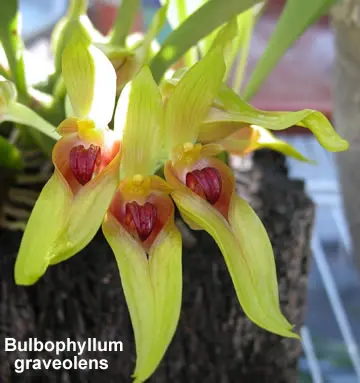 |
||
| Bulbophyllum
One of the largest genus which is divided into subgenera, some 1200 in total. Most of the species are from the cloud forests of south east Asia, in particular New Guinea, which is believed to be the center of distribution. |
||
| Bulbophyllum graveolens A species from New Guinea and does best under warm to intermediate conditions with bright filtered light. A basket or mount will best accommodate the sprawling growth habit. Sepals and petals are pale green and the labelum red. |
||
| /\ Top of Page | ||
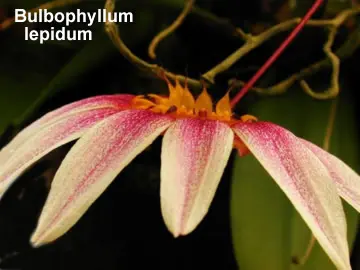 |
||
| Bulbophyllum
One of the largest genus which is divided into subgenera, some 1200 in total. Most of the species are from the cloud forests of south east Asia, in particular New Guinea, which is believed to be the center of distribution. |
||
| Bulbophyllum lepidum Accepted name Bulbophyllum flabellum-veneris. Distributed from Indo-China to Malaysia, it is a small plant which will form a large clump if grown well. It produces 4cm fan-type umbel which is yellow flushed redpurple at base of petals. A good grower, it will wrap around a basket to form a specimen, and likes plenty of water. |
||
| /\ Top of Page | ||
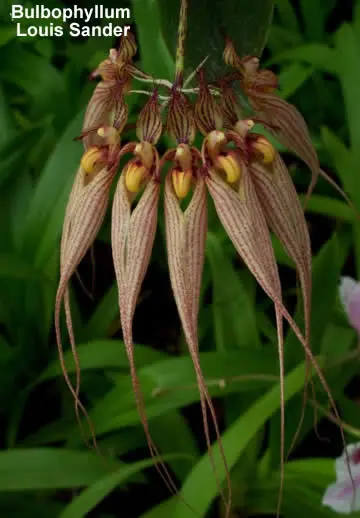 |
||
| Bulbophyllum
One of the largest genus which is divided into subgenera, some 1200 in total. Most of the species are from the cloud forests of south east Asia, in particular New Guinea, which is believed to be the center of distribution. |
||
| Bulbophyllum louis sander Primary Hybrid: (Bulbophyllum longissimum x Bulbophyllum ornatissimum) developed in 1936 |
||
| /\ Top of Page | ||
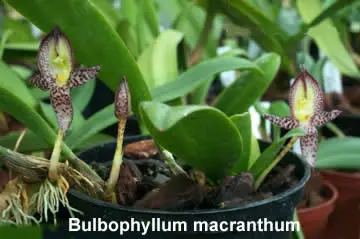 |
||
| Bulbophyllum
One of the largest genus which is divided into subgenera, some 1200 in total. Most of the species are from the cloud forests of south east Asia, in particular New Guinea, which is believed to be the center of distribution. |
||
| Bulbophyllum macranthum Distributed from Assam to Indo-China and Solomon Is. A warm grower, give good sunlight to promote flowering. In active growth, give plenty of water and fertiliser. Some winter rest with slightly drier conditions. |
||
| /\ Top of Page | ||
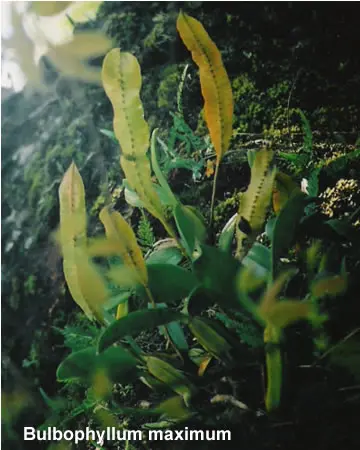 |
||
| Bulbophyllum
One of the largest genus which is divided into subgenera, some 1200 in total. Most of the species are from the cloud forests of south east Asia, in particular New Guinea, which is believed to be the center of distribution. |
||
| Bulbophyllum maximum Accepted name Bulbophyllum virescens Found in all of tropical Africa as a hot to warm growing, bifoliate epiphyte and an occasional lithophyte in open woodlands and riverine forests at elevations of 600 to 2100 meters with oblong to ovoid pseudobulbs carrying to 3, apical, oblong, apex rounded and emarginate thick and leathery leaf that blooms on a single, basal, erect, 20" [50 cm] and more long, inflorescence arising on a mature psuedobulb with many [50], small, successive opening flowers spread out along the leaflike, flattened rachis with dentate edges occuring in the fall. This plant needs a distinct dry period in the winter as you do need some pseudobulb shriveling for strong growth to come on in the spring |
||
| /\ Top of Page | ||
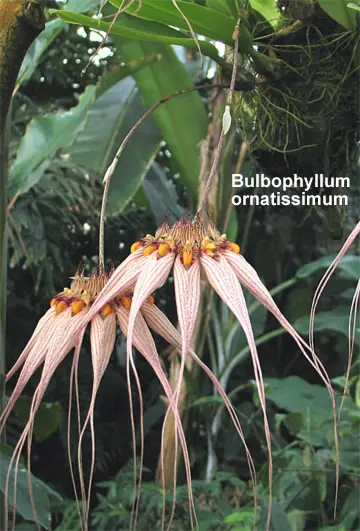 |
||
| Bulbophyllum
One of the largest genus which is divided into subgenera, some 1200 in total. Most of the species are from the cloud forests of south east Asia, in particular New Guinea, which is believed to be the center of distribution. |
||
| Bulbophyllum ornatissimum Distributed from India to Nepal. This orchid prefers intermediate temperatures, it will thrive in a basket where the long lateral sepals can dangle |
||
| /\ Top of Page | ||
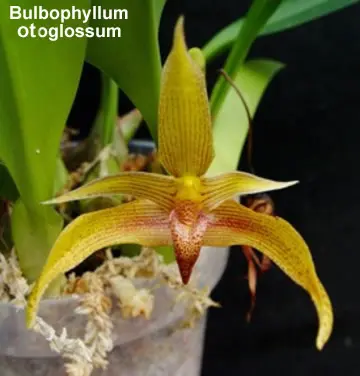 |
||
| Bulbophyllum
One of the largest genus which is divided into subgenera, some 1200 in total. Most of the species are from the cloud forests of south east Asia, in particular New Guinea, which is believed to be the center of distribution. |
||
| Bulbophyllum otoglossum Found from Nepal to China living on forest rocks. It has narrow oval pseudobulbs with rhizome creeping roots. Inflorescence stem is short with three or four flowers. |
||
| /\ Top of Page | ||
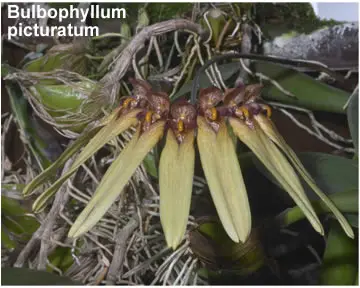 |
||
| Bulbophyllum
One of the largest genus which is divided into subgenera, some 1200 in total. Most of the species are from the cloud forests of south east Asia, in particular New Guinea, which is believed to be the center of distribution. |
||
| Bulbophyllum picturatum Assam to Indo-China. Elongated, yellow flowers make a beautiful umbel on this intermediate, moderate light species. Sends out multiple spikes at least twice a year. Likes it on the humid side. Grow in a basket |
||
| /\ Top of Page | ||
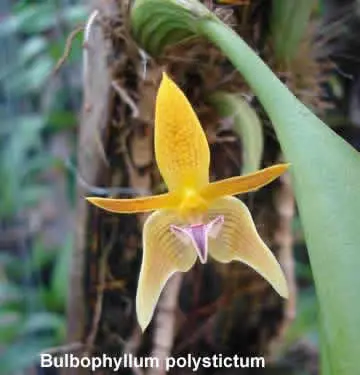 |
||
| Bulbophyllum
One of the largest genus which is divided into subgenera, some 1200 in total. Most of the species are from the cloud forests of south east Asia, in particular New Guinea, which is believed to be the center of distribution. |
||
| Bulbophyllum polystictum An easy cultivated species from Indonesia. It blooms in the spring with flowers measuring 10cm wide. It prefers intermediate conditions. |
||
| /\ Top of Page | ||
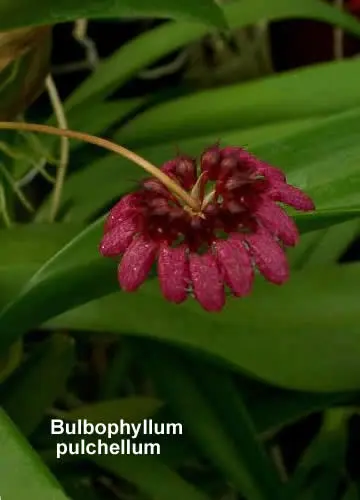 |
||
| Bulbophyllum
One of the largest genus which is divided into subgenera, some 1200 in total. Most of the species are from the cloud forests of south east Asia, in particular New Guinea, which is believed to be the center of distribution. |
||
| Bulbophyllum pulchellum Distributed from Thailand to Borneo it makes loads of very nice red whols which almost resemble fruits. These can make very nice displays as the plant gets larger and are super as basket plants.It will do best in warm to intermediate conditions under medium to low light and does fine in pure NZ moss or mounted on tree fern. |
||
| /\ Top of Page | ||
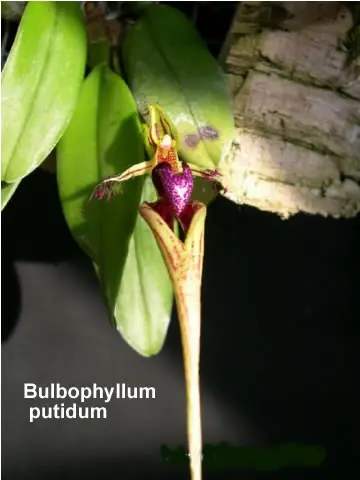 |
||
| Bulbophyllum
One of the largest genus which is divided into subgenera, some 1200 in total. Most of the species are from the cloud forests of south east Asia, in particular New Guinea, which is believed to be the center of distribution. |
||
| Bulbophyllum putidum Syn.Mastigion putidum. Single long flowers with mobile lip & protruding hairs. Dorsal & petals have purple tassles, sepals elongated fusing then separating. Grow intermediate with moderate light |
||
| /\ Top of Page | ||
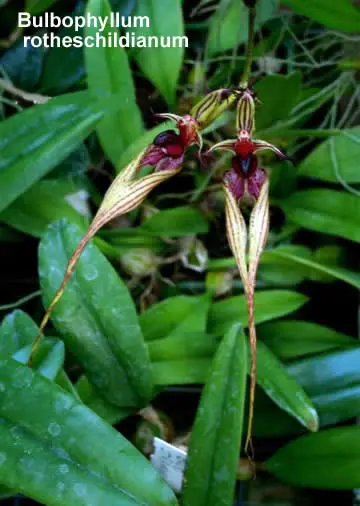 |
||
| Bulbophyllum
One of the largest genus which is divided into subgenera, some 1200 in total. Most of the species are from the cloud forests of south east Asia, in particular New Guinea, which is believed to be the center of distribution. |
||
| Bulbophyllum rothschildianum Found in India & the Himalayas. It produces long inflorences of three or more flowers produced from the base of the pseudobulb. The sepals are almost 15cm long and the flowering period is from September to March. |
||
| /\ Top of Page | ||
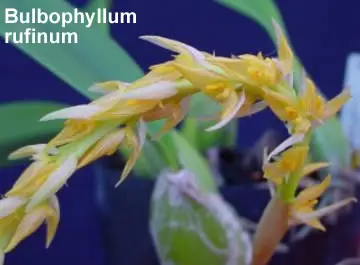 |
||
| Bulbophyllum
One of the largest genus which is divided into subgenera, some 1200 in total. Most of the species are from the cloud forests of south east Asia, in particular New Guinea, which is believed to be the center of distribution. |
||
| Bulbophyllum rufinum Range from Myanamr, Thailand, Laos, Viet Nam and Kampuchea. Grow in warm conditions on a raft or slab for best effect. |
||
| /\ Top of Page | ||
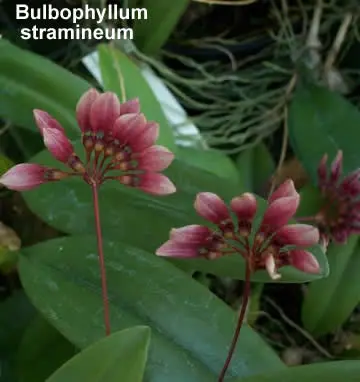 |
||
| Bulbophyllum
One of the largest genus which is divided into subgenera, some 1200 in total. Most of the species are from the cloud forests of south east Asia, in particular New Guinea, which is believed to be the center of distribution. |
||
| Bulbophyllum stramineum Native of the Philippines. Grow in warm conditions. |
||
| /\ Top of Page | ||
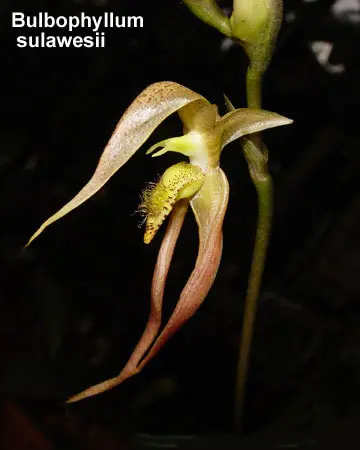 |
||
| Bulbophyllum
One of the largest genus which is divided into subgenera, some 1200 in total. Most of the species are from the cloud forests of south east Asia, in particular New Guinea, which is believed to be the center of distribution. |
||
| Bulbophyllum sulawesii This species is found on the island of Sulawesi at between 1200 to 1500m. The pseudobulb has a single leaf and usually bears around 10 flowers which open successively in during spring and summer. Found in rainforest as an epiphyte, grow in warm conditions. |
||
| /\ Top of Page | ||
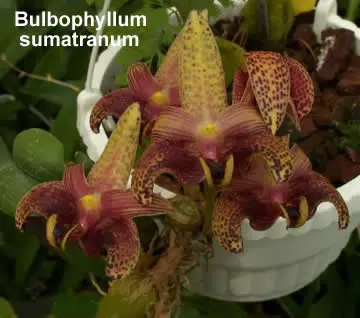 |
||
| Bulbophyllum
One of the largest genus which is divided into subgenera, some 1200 in total. Most of the species are from the cloud forests of south east Asia, in particular New Guinea, which is believed to be the center of distribution. |
||
| Bulbophyllum sumatranum Found in Sumatra as a warm growing epiphyte that requires shade, and high humidity. This large-flowered species has yellow or ivory sepals with dark red-brown spots. The petals are yellow to cream with red-brown stripes, and the lip is red-purple edged in yellow. |
||
| /\ Top of Page | ||
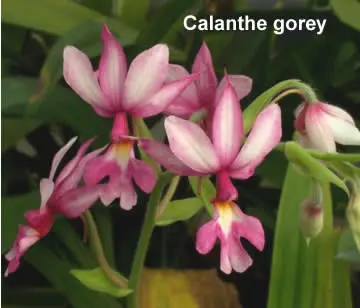 |
||
| Calanthe
Approx 150 terrestial species distributed throughout subtropical Africa, Asia and Australia. These orchids should be grown in a peat / pearlite compost and given planty of light and heat. Flowering time is usually November to January. |
||
| Calanthe Gorey The plants form large palm-like light green leaves in the growing season (Spring into Summer) and go decidiuous in the Fall to Winter season. It is at this time that the majestic spikes develop, reaching up 50cm before cascading downward for a stunning display. The flowers last for months when bloomed under cool and dry conditions, at which time watering should be done sparingly; once every 2-3 weeks. |
||
| /\ Top of Page | ||
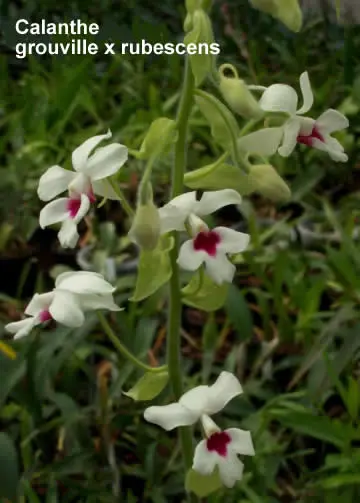 |
||
| Calanthe
Approx 150 terrestial species distributed throughout subtropical Africa, Asia and Australia. These orchids should be grown in a peat / pearlite compost and given planty of light and heat. Flowering time is usually November to January. |
||
| Calanthe grouville The plants form large palm-like light green leaves in the growing season (Spring into Summer) and go decidiuous in the Fall to Winter season. It is at this time that the majestic spikes develop, reaching up 50cm before cascading downward for a stunning display. The flowers last for months when bloomed under cool and dry conditions, at which time watering should be done sparingly; once every 2-3 weeks. |
||
| /\ Top of Page | ||
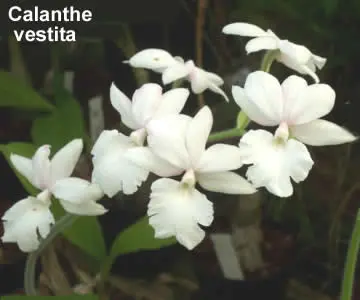 |
||
| Calanthe
Approx 150 terrestial species distributed throughout subtropical Africa, Asia and Australia. These orchids should be grown in a peat / pearlite compost and given planty of light and heat. Flowering time is usually November to January. |
||
| Calanthe vestita Native of Indo-China, Malesia to New Guinea. The plants form large palm-like light green leaves in the growing season (Spring into Summer) and go decidiuous in the Fall to Winter season. It is at this time that the majestic spikes develop, reaching up 100cm before cascading downward for a stunning display. The flowers last for months when bloomed under cool and dry conditions, at which time watering should be done sparingly; once every 2-3 weeks. |
||
| /\ Top of Page | ||